Antinol® Latest Studies
Sorted by recent
 Filter Studies by Smart Tags
Filter Studies by Smart Tags
Bone & JointCardiovascularCase Study & ProceedingCatDogEAB 277™EfficacyExotic PetImmunologyNeuro & BehaviorOphthalmologyOralRabbitRenalRespiratoryRodentSafetySkinUTI
Smart Search
Safety study of polyunsaturated fatty acids extracted from New Zealand green lipped mussel and krill on hematology and blood chemistry profiles of healthy

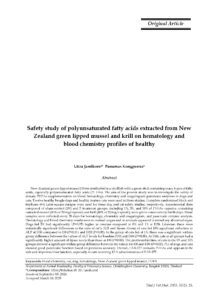
Abstract
New Zealand green-lipped mussel (Perna canaliculus) is a shellfish with a green shell containing many types of fatty acids, especially polyunsaturated fatty acids (PUFAs).
The aim of the present study was to investigate the safety of dietary PUFAs supplementation on blood hematology, chemistry and coagulogram pancreatic enzymes in dogs and cats. Twelve healthy beagle dogs and healthy mature cats were used in these studies. Complete randomized block and triplicate 4×4 Latin square designs were used for these dog and cat safety studies, respectively. Experimental diets composed of sham control (0X) and 3 treatment groups, including 1X, 3X, and 10X of PUFAs capsules containing extracted mussel (60% or 30 mg/capsule) and krill (40% or 20 mg/capsule), were given consecutively for 56 days.
Blood samples were collected every 28 days for hematology, chemistry and coagulogram, and pancreatic enzyme analysis. Hematology and blood chemistry results were in normal ranges and no animals appeared to reveal any abnormal signs.
Dogs fed 3X had significantly (P<0.05) higher in creatine compared to 0X and 1X at D28. Likewise, there were statistically significant differences in the time of cat’s ALT and lipase. Group of cats fed 10X significant reduction in ALT at D56 compared to D0 (P<0.01) and D28 (P<0.05).
In the group of cats fed at 1X, there was a significant within-group difference between the values of ALT levels for baseline (D0) and D56 (P<0.05). At D56, cats in all groups had a significantly higher amount of lipase levels than those at D0 (P<0.05). The prothrombin time of cats in the 0X and 10X groups showed a significant within-group difference between the values for D0 and D56 (P<0.05). PLI of dogs and cats showed good pancreatic function based on precision accuracy.
Overall, EAB-277 contains PUFAs and appears to be safe and improves liver function, especially in cats receiving 10 X administration of EAB-277.
Keywords: blood chemistry, cat, dog, hematology, New Zealand green lipped mussel, PUFA


The Effectiveness of Marine Based Fatty Acid Compound (PCSO-524) and Firocoxib in the Treatment of Canine Osteoarthritis

This randomized double blinded study included 79 mixed breed dogs that had hip and/or stifle OA with X-ray confirmation. Outcome measures were changes in Kinetic force plate gait analysis-Peak Vertical Force (PVF), the Orthopedic Assessment Score (OAS), Canine Brief Pain Inventory score (CBPI), and serum prostaglandin E2 concentration (PGE2).
The results of the study suggest that within each group of a combination (PCSO-524 and Firocoxib), PCSO-524, Firocoxib showed the significant improvement of weight bearing ability but not in the comparison between.
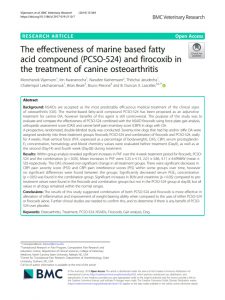


Antinol® Case Study Contest 2020

The 8 Case Studies from Antinol® Case Study Contest of 2020.
________
1st Winning Awards
1) Use of PCSO-524® and Cyclosporin for Treatment of Immune-Mediated Polyarthritis in Dogs
2) Use of PCSO-524® for Supplementary Treatment of Protein Losing Nephropathy in Animals
________
2nd Winning Awards
3) Use of PCSO-524®(Antinol®) in a Pomeranian Dog with Degenerative Mitral Valve Disease (DMVD) and Cardiac Tumor of the Left Atrium
________
3rd Winning Awards
4) Use of PCSO-524 (Antinol®) for Treatment of Chronic Pododermatitis in FIghting Cocks
5) Use of PCSO-524® with Physical Rehabilitation to Regain Mobility in Dogs after Femoral Head and Neck Excision
6) Use of PSCO-524® (Antinol®) and Casting for Treatment of Tetraparesis and Neck Pain Due to Atlantoaxial Instability and Subluxation of the 1st-2nd Cervical Vertebrae
7) Effect of One Year Treatment with PCSO-524® on Feline Dermatophytic Pseudomycetoma

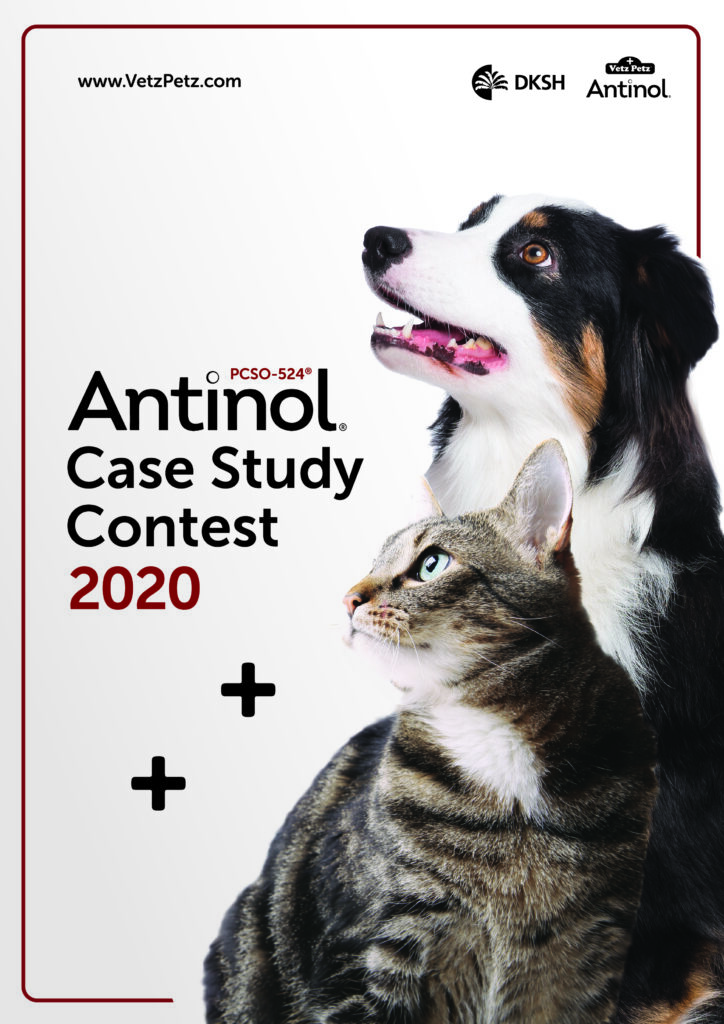
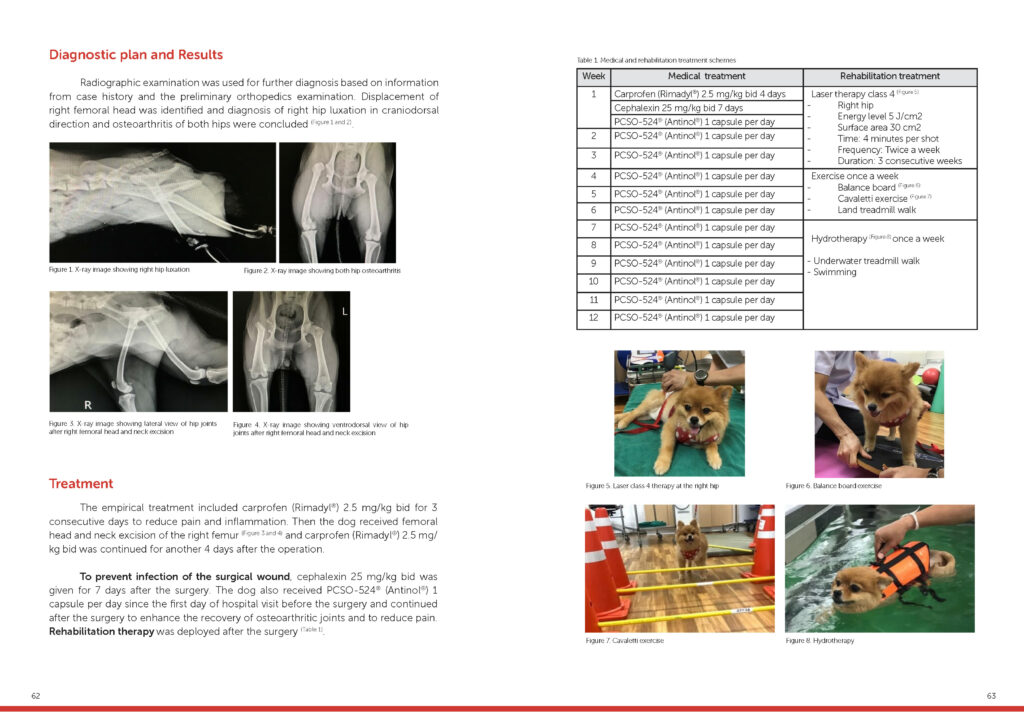
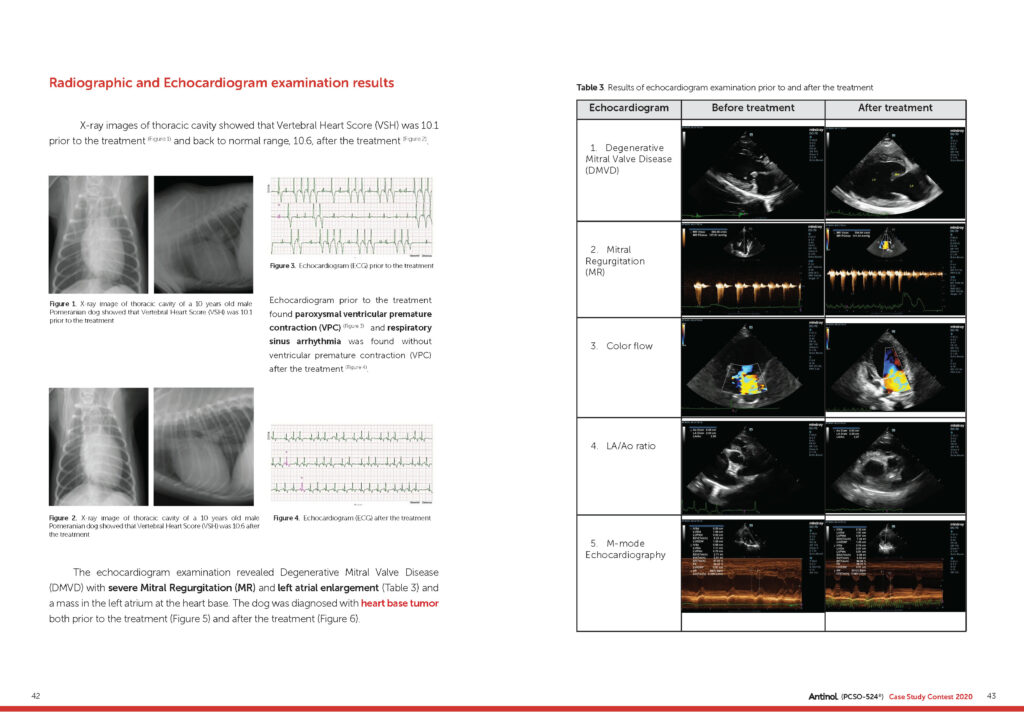
Use of PCSO-524® and Cyclosporin for Treatment of Immune-Mediated Polyarthritis in Dogs

An 8 years old Chihuahua dog was admitted to the Small Animal Hospital at Chulalongkorn University due to signs of depression, lethargy, lameness and joint effusion. Hematological examination and test of synovial fluid indicated Immune-Mediated Polyarthritis (IMPA).
Prednisolone, Gabapentin and Amoxillin-clavulanic acid were prescribed for the treatment. Abnormally increase of ALT, ALK and AST enzyme was observed 1 week later, therefore, the treatment was changed to Cyclosporin, Gabapetin, and PCSO-524®. The clinical signs continued to improve after the adjustment of prescription and Cyclosporin and Gabapetin were terminated after 3 and 4 months, respectively.
A follow-up examination at 4 months later showed no signs of lameness and joint effusion and no adverse effects caused by the long-term use of PCSO-524®.
The success of IMPA treatment is a result of rapid diagnosis and appropriate treatment protocol. Follow-up for treatment evaluation is necessary during the treatment course in order to reduce the impact on health and minimize the medication dosage without risk of causing adverse effects or recurrence of the disease.

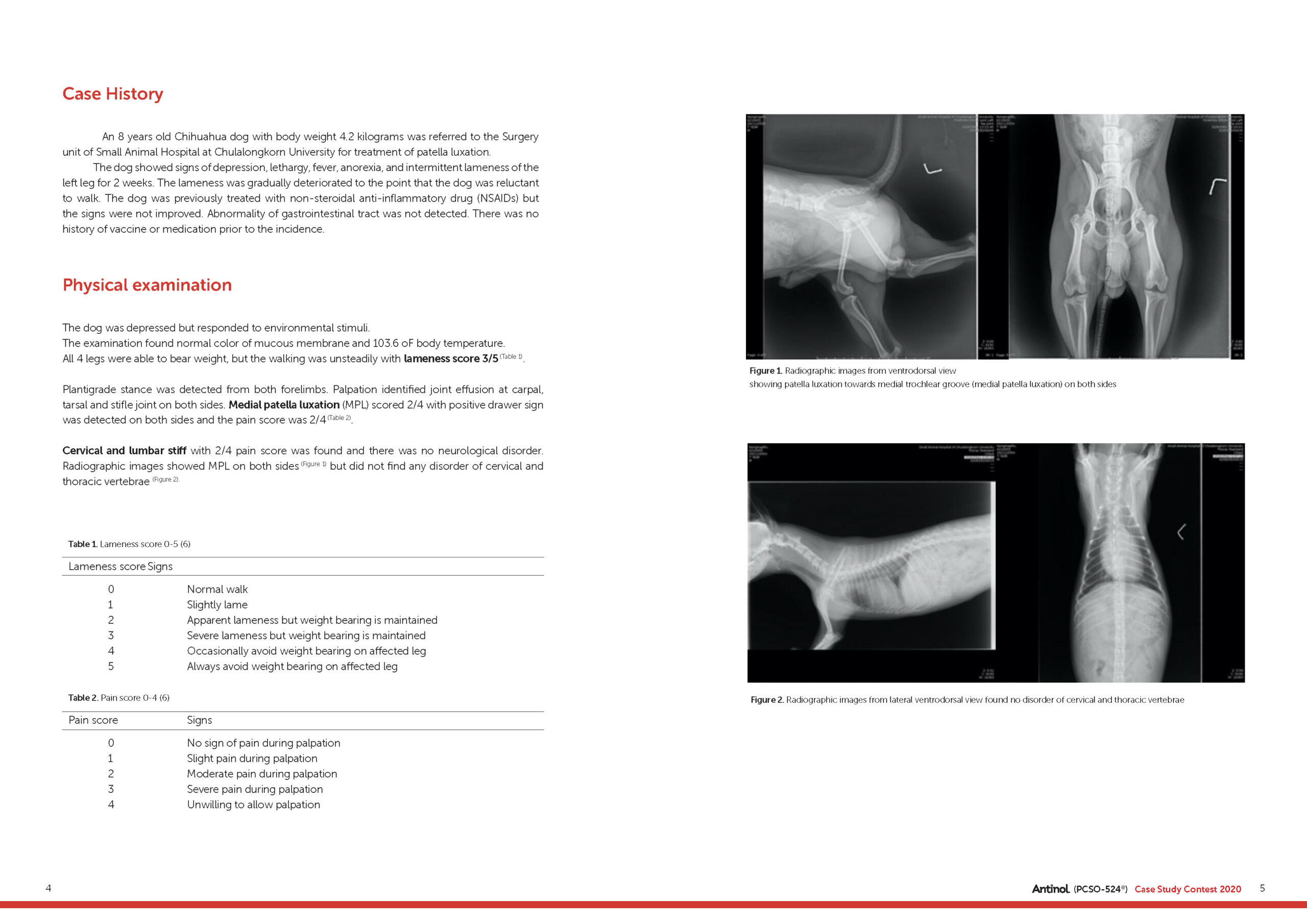
PCSO-524® for Treatment of Immune-Mediated Polyarthritis in Dogs

An 8-year old Chihuahua dog was admitted for surgical treatment of patella luxation at Small Animal Hospital of Chulalongkorn University, Thailand.
At 2 weeks prior to the hospital visit, the dog showed signs of fever, anorexia, lethargy, and lameness of the left leg. Non-steroidal anti-inflammatory drug (NSAIDs) was prescribed at that time but the dog had no response to the treatment.
The dog received prednisolone 0.6 mg/kg bid, gabapentin 10 mg/kg sid, samylin® liver supplement 1 tablet sid, and amoxicillin-clavulanic acid 20 mg/kg sid in the first week of the treatment. Then prednisolone was stopped due to elevation of liver enzymes; AST, ALT, and ALK.
The following 1-month treatment course included cyclosporine 6 mg/kg bid, gabapentin 10 mg/kg bid, samylin® 1 tablet sid, and PCSO-524® 1 capsule bid.

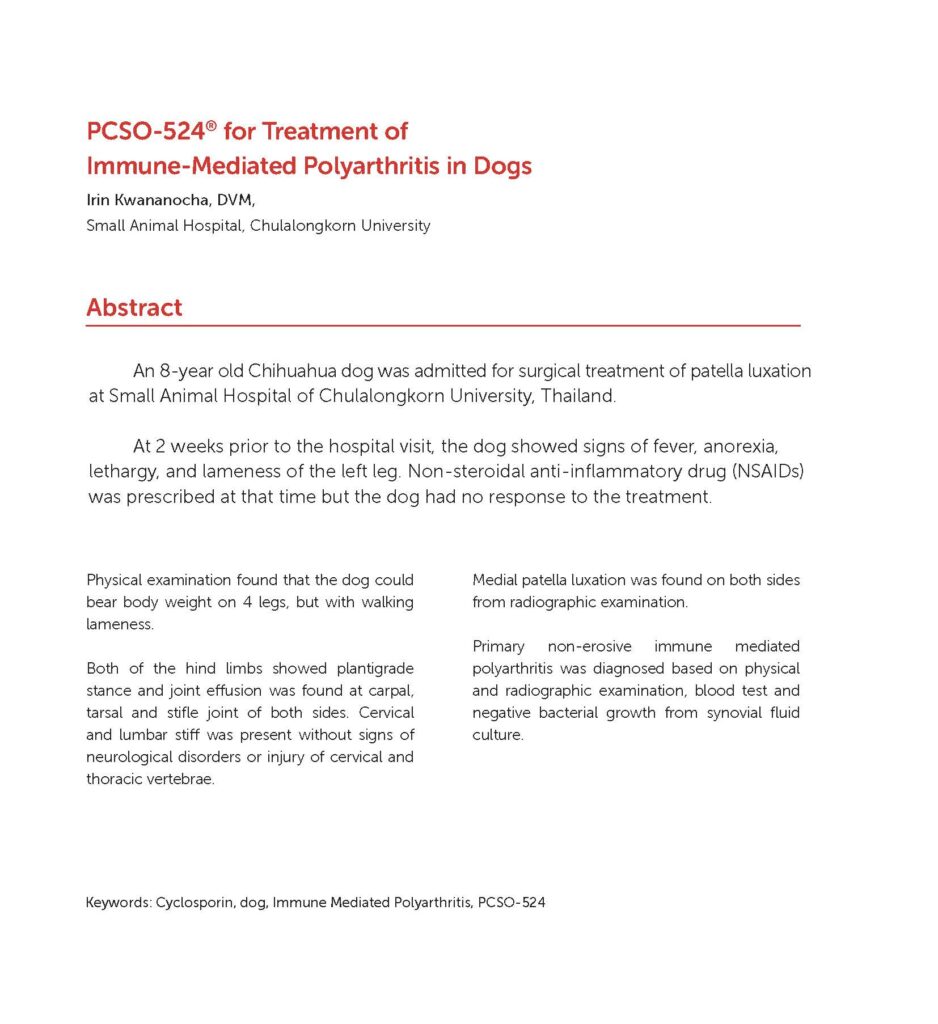

This article was summarized from the original article published in The Journal of Thai Veterinary Practitioners by the permission of Veterinary Practitioner Association of Thailand (VPAT)
Clinical Effect of PCSO-524® on 3 Osteoarthritic Cats Associated with Chronic Kidney Disease

Three cats suffering from chronic kidney disease were admitted to animal hospital.
The first cat showed sudden onset of right hindlimb pain without apparent cause. Bladder stone was found in the second cat while the third cat was admitted for nursing care. Caging was applied and fluid therapy were administered for the third cat. All 3 cats had never been diagnosed with arthritis prior to the admission.
X-ray examination showed symptoms of arthritis at hip and stifle joints. PCSO-524® was then administered daily for 60 days.
Pain evaluation using Feline Musculoskeletal Pain Index (FMPI), which is a reliable and effective method for pain evaluation in cats (Benito et al., 2013), showed that, after the treatment, chronic pain was decreased in all of the cats (Appendix 1). The cats’ behavior was nearly normal compared with the behavior before the treatment. Interaction between the cats and owners was improved as well.
By the end of the experiment, UP/C ratio was not altered and blood creatinine tended to decrease.

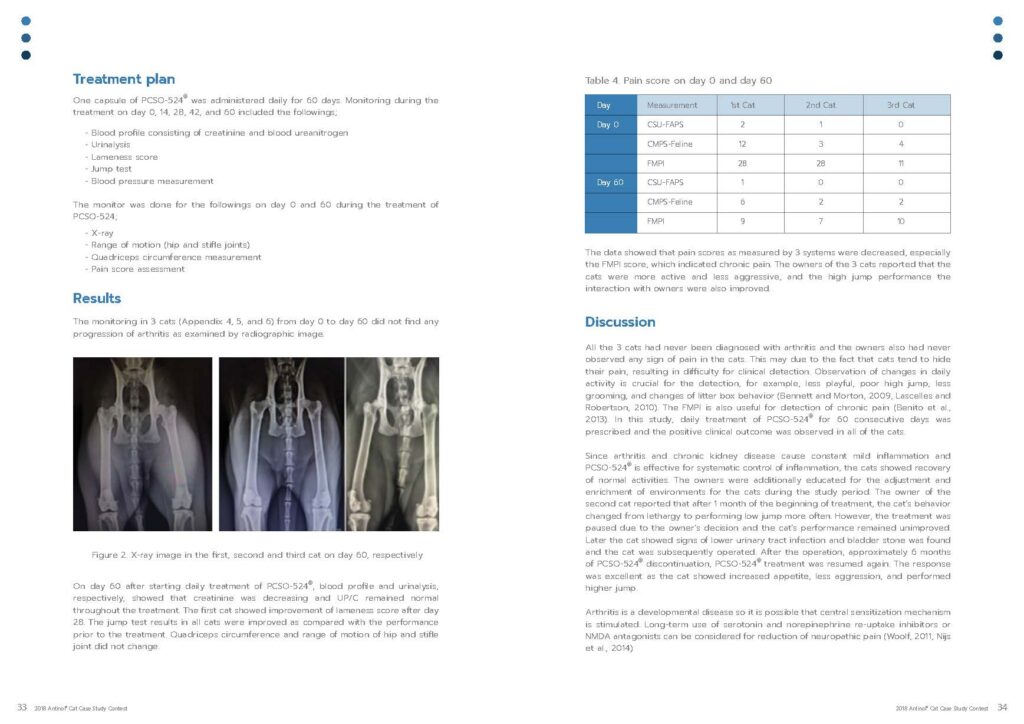
Clinical study of PCSO-524 (ANTINOL™) as neutraceutical in canine allergic skin disease

This study included 31 allergic dogs with chronic pruritis with other skin diseases excluded.
Dogs were split into 3 treatment groups based on degree of pruritis, distribution, extension of the lesions and skin and coat condition; Group 1: mild, Group 2: moderate, and Group 3: severe.
All dogs received PCSO-524 loading dose 10 mg/kg q12hr PO for 2 weeks followed by a maintenance dose of 10 mg/kg q24hr PO.
All dogs were evaluated at 2, 4, 8, 12 and 16 weeks for clinical response. The assessment made by the owners (PVAS Score) and Vets (CADESI-03 score).



Antinol® Case Study Contest 2017

10 Case Reports using PCSO-524® in combination with the treatment regimen for dogs and cats.
Pharmalink International Ltd. and Vetz Petz® would like to thank everyone involved in this 2017 Antinol® Case Study Contest competition and pay homage to our Professors and Veterinarians who have assisted in the judging of the competition.
This 2017 contest was very special with the inclusion of Professor Duncan Lascelles and the wonderful innovation of the live poll that the audience took part in to choose the Vets choice and favorite presentation.




Use of PCSO-524® Combined with Surgical Treatment of Patellar luxation in Dogs

Five dogs with bilateral patellar luxation were presented at the Small Animal Hospital of Faculty of Veterinary Medicine, Chulalongkorn University.
Four dogs had grade 2, 3, and 4 medial patellar luxation in 3, 3, and 2 stifle joints, respectively. One dog had grade 3 bilateral lateral patellar luxation that had recurrent patellar luxation of left stifle joint for 6 months after previous surgery. All dogs had surgical treatment to re-align and stabilize extensor mechanism in the normal position.
The dogs received anti-inflammatory drug and PCSO-524® in combination with rehabilitation to restore normal limb function and muscle mass postoperatively. All dogs achieved good outcomes when compared with pre-operation. Range of motion was normal in all dogs and the patellae were in the normal position.
However, one stifle with previous reluxation and severe osteoarthritis had slightly crepitation when flexed and extended the stifle joint. Patellar luxation causes abnormal wear of the patella and trochlear ridges leading to lameness, muscle pain, and osteoarthritis.
The treatment focuses on stabilization of the stifle joint and restore limb function. Surgical treatment is recommended in most cases. Rehabilitation provides strengthen muscle, improves normal joint function, enhanceslimb function, and prevents complications.
Despite successful treatment for correcting patellar luxation, osteoarthritis remains occurrence in most cases.
Therefore, use of anti-inflammatory supplement such as PCSO-524® is important for long-term management with less side effect and safety for long-term use when compared with non-steroidal anti-inflammatory drugs.

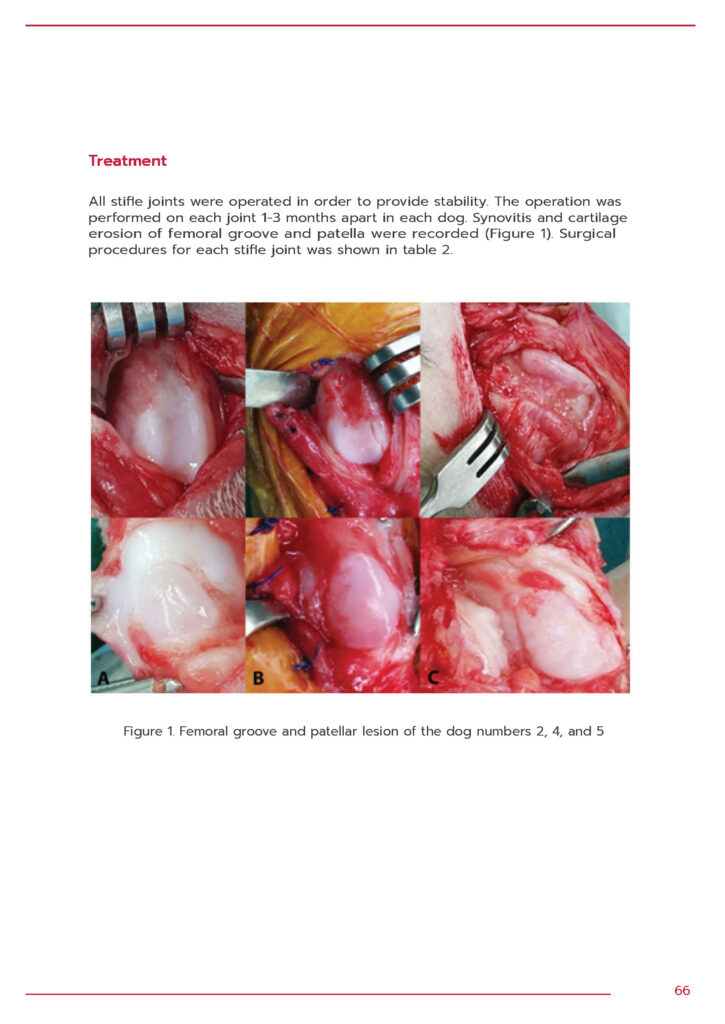
Use of PCSO-524® for Treatment of Spine Fracture in Conjunction with Pedicle Screw-Rod Fixation (PSRF)

An intact male mixed breed dog aged 2 years engaged in a fight with several dogs resulting in disable of hind limbs and loss control of elimination. Physical and radiographic examination showed fracture and luxation of the 7th lumbar vertebrae. Spinal cord injury (SCI) was also found and the fracture was identified as the cause. The spinal cord trauma could occur since the incident and was left for more than 2 weeks.
Pedicle screw-rod fixation (PSRF) was operated to fix the vertebral column. After the second operation, it was suspected that there was remain of inflammatory cytokines that probably increased after the operation. Anti-inflammatory medication for prohibition of inflammatory cytokines synthesis was essential but its adverse effect must be concerned. The study therefore used holistic treatment including PSRF, non-steroidal drug and PCSO-524® anti-inflammatory extract, in conjunction with physical therapy.
Follow-up examination on neurological system, walking, and urinary system showed promising result. The neurological system was restored, and adverse effect of long-term use had not been found.
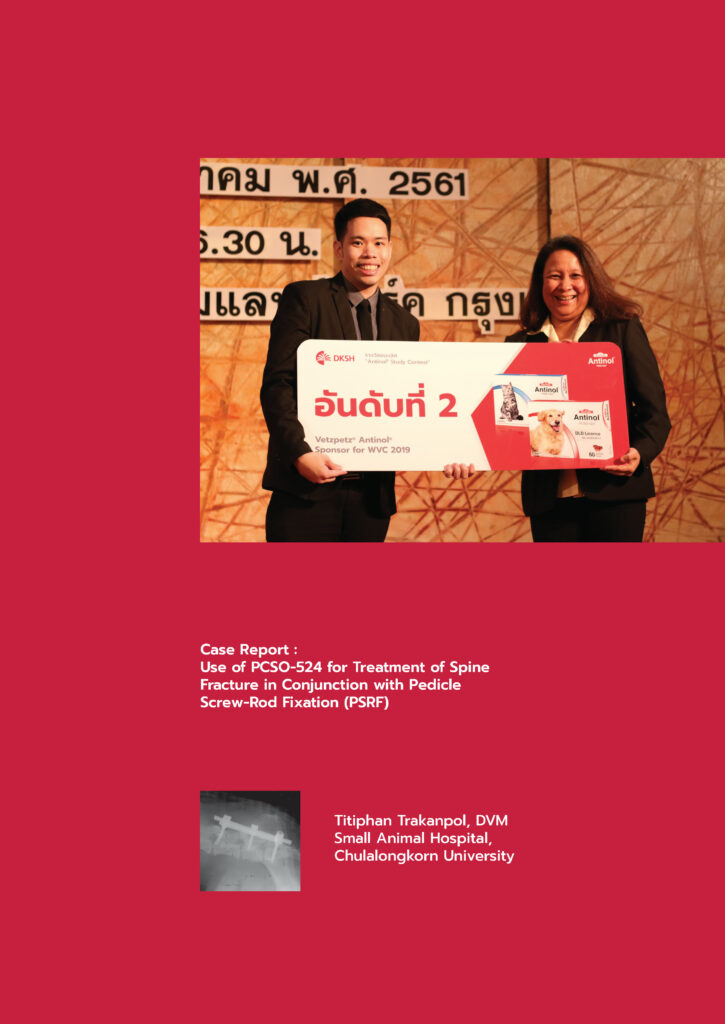

Updated Study Topics
New researches and publications related to PCSO-524® and its result in clnical test submitted by veterinarians on the global conferences every year and the data keeps growing with more studies conducted


 Authors:
Authors: